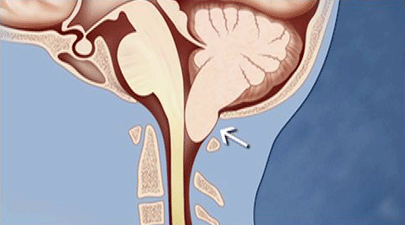Chiari malformation type 1 (Chiari) [kie-ja-rie] is a structural abnormality in the back of the brain and skull. Normally, a large hole in the base of the skull provides the connection between the brain and the spinal cord. This connection point is surrounded by fluid that can move freely between the head and the spine. In a person with a Chiari, the back of the brain (the cerebellum) is pushed down through this opening, putting pressure on the spinal cord and limiting that fluid movement between the head and spine. That pressure leads to a wide variety of symptoms, the most common of which are headaches and neck pain, which tend to get worse with exertion (exercise, coughing, sneezing and even laughing).

The arrow shows the cerebellum that has sunk through the occiput.
Chiari's treatment: If surgery is required, the patient will undergo decompression surgery. As the name suggests, the purpose of this procedure is to reduce or eliminate pressure on the spinal cord caused by the cerebellum. Almost all patients undergoing decompression surgery experience partial or total improvement in their symptoms, with very little risk. A piece of skull is then removed, the dura will be opened to insert an extra piece of dura so that the cerebellum has more space.
Zjuul has a poor brain fluid flow. This is because the cerebellum closes the opening of the occiput.
